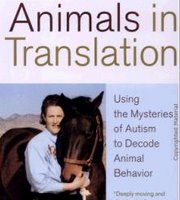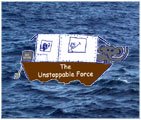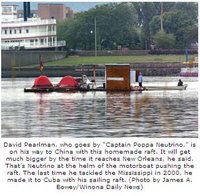![]()



Born in Czechoslovakia, in 1931
Kurt Gödel demonstrated that some propositions could not be mathematically proven true or false using the rules and axioms
within a given mathematical system.
Outside it, the system could be proved or disproved, but by doing so you would only create a larger system with its own unprovable statements.
So what?, you ask. Only this. Gödel undermines any belief that all complex logical systems are logically air-tight—that they contain undeniable truths within them so long as rules and axioms are observed. Instead, each system holds more true statements than it can possibly prove.
This has far-reaching implications.
His Theorem can be used against artificial intelligence as eventually somehow becoming as smart as people. A computer can never be, because its knowledge is limited by a fixed set of axioms.
For my purposes, it also applies to the realm of consciousness. Some neuroscientists and philosophers of consciousness are bravely optimistic that the processes of consciousness can finally be explained. Gödel's
Incompleteness Theorem offers a way to see this as unlikely. You can be sure of what consciousness knows only by relying on what it knows about itself. That which it knows is subjective. You must be somehow able to objectify it to explain it. The problem is that here is no molecular structure, no particles. If you say neurons, you say nothing about what it feels like to be you.
In a phrase, neuroscientists and philosophers will always depend on. By that phrase, I refer to the use of words to stand for what is not understood. They range from the metaphysical (God) to the physical (dark energy). Mainly, though, I see them operative in the study of consciousness. Note the shift in neurophysiological parlance from
matter to
physical processes. Matter had once held a promise that it could be plumbed, that somewhere at its base, science would shout Eureka! after years of hard research. The discovery did not happen. Instead, matter behaved very strangely indeed and invited strange imaginings to explain its behavior. The Standard Model of quantum physics wouldn't cooperate with gravity in General Relativity. Now we have the wholly unverifiable
excitation modes of String Theory. As quantum physicist Richard Feynman said in a different context, if a scientist isn't confused by it all, he doesn't understand it well enough.
Especially for the study of consciousness,
the new linguistic place holder is physical processes, with its implication that
matter has been discarded as a hopeless dead end. The new term does not insist on a basement order for physical things, which was the expectation of
matter. Instead, processes occur, which are called physical. These processes will eventually be determined, so goes the belief.
Of course, that still leaves the question,
What does physical mean? Sounds like a glib replacement for
matter to me. The shift from
matter to
physical is intended to support the meta-paradigm of science—the overarching view that the real world is composed of space, time, and the physical. To slightly alter Hamlet, There are more things in heaven and earth, Horatio, than are dreamt of in your meta-paradigm.
The meta-paradigm holds that only the physical—or the material, if you want—is real. Real? Even if, by that, you mean physical reality, problems still occur. The European cuckoo never sees its parents. It is raised by birds of other species. Near summer’s end, its parents migrate southward to southern Africa, without even a goodbye to their offspring. A month later, the young cuckoo locates other youngsters, and together they also migrate. How can this be?
Any answer is superficial if it merely asserts that the instinct is encoded in DNA or passed on through genetic chemicals. It still has not explained how the instinct works. It has resorted to
physical processes with more specific words.*
The meta-paradigm does not allow for the existence of any non-physical, non-material, causal agency, nor should it, for--scientifically speaking--any other approach is useless. It's just that when research comes down to consciousness, more humility is in order.
The meta-paradigm allows that swimming around in the primordial soup, life began. Okay. Allow that physical reality has a wholly convincing explanation in this regard—it still would not explain the nature of life. Is that nature physical? This is a pointless question according to the meta-paradigm, which holds that this sense of the word
nature is like the word
God, simply a universal idea created by the human mind. Mechanical causation would be enough. Nature is described by what happens. Would this causation be enough? Enough for what? For scientific explanation? As far as it can go.
Science has serious problems with cause and effect. It operates predictably in the macro-world, but behaves quite oddly in the micro-world. Evidence for this behavior abounds at the quantum level. To use a classic example, how can a wave also be a particle? What about the so-called
Observer’s Paradox? How can the wave function collapse as soon as it is recorded? Problems with consciousness occur at the quantum level. Consider
Bell’s Theorem, which demonstrates what
Einstein called spooky action at a distance. How does an electron here know what is happening to an electron a million miles over there? Quantum computers may be invented out of this entanglement, but that only means we know how to harness it, not that we understand it in a realm where our cause and effect become confused.
Erwin Schrödinger described the time-dependence of a quantum mechanical system with his equation, which today is fundamental in quantum mechanics as a description of the system. Among scientists, Schrödinger had a nimble mind with interests spanning numerous fields, which gave him versatility. This allowed him to see and think outside the box of science. In
My View of the World, (
Meine Weltansicht), he expressed an outlook rooted in the ancient Sanskrit teachings of the Vedanta. Written in 1961, his book reveals the culmination of his search for understanding of consciousness. In it he said, “the plurality of sensitive beings is mere appearance (
maya); in reality they are all only aspects of the
one being.” As a scientist he sought the physical processes of that unity; as an individual he had an understanding where science could not go. He saw deeply into the paradox of objectivity. Were his consciousness not part of the real world, and he must exclude it, then he must exclude objective manifestations of consciousness—his body, others’, as well as the objective manifestations (consciousness) of their brains. Were he to exclude his own manifestations, he would deny his own existence.
Make no mistake. I carry no brief for obscurantism, for mystery. Perhaps consciousness does have a “physical” basis. Maybe consciousness is a feature of certain elementary particles. (That still leaves the door open for God—or the Gaia hypothesis, if you prefer.) The Observer Paradox and other phenomena suggest that some particles have potential for consciousness, just as particles have potential for an electrical charge. (Indian guru
Ramesh Balsekar tells his many disciples that Consciousness
is all. Sorry Ramesh. In this view, Consciousness is not all. All carry the potential for it while only some are.)
It's just that we are part of the system trying to find out what we are. That's where Gödel's Incompleteness Theorem comes into play. We are what we are looking for, as
St Francis of Assisi is alleged to have said. Or, the eye cannot see itself, nor can consciousness. In our long evolution we developed the smarts to understand, describe, and predict much of the three dimensional world. This ability accelerated with the rise of modern science. I find it likely that we just do not have the right kind of intelligence to understand consciousness, somehow entangled with what we call time. (Try to explain time.) To be sure, linguistic analogs for consciousness processes will be developed and they will provide models for thinking about consciousness. They will remain only that—models, and with large areas of theory unavailable for verification or a Unified Theory of Consciousness. I cannot muster any enthusiasm for the optimism of those who hold that consciousness can be fully explained, although I believe their thinking and research is valuable. They and others have enabled a discussion that was long overdue.
I grant that Gödel's is a mathematical system, and can only be used as a metaphor of consciousness. He only served my introduction. My point is that, given my explanations, at the intersection of mind with matter I cannot foresee anything but more linguistic place holders for investigators of consciousness processes. Because the neuroscientific community has not questioned the meta-paradigm of science, that model remains as Holy Mother Church for the belief that the intersection of consciousness with matter can be adequately explained.
Look at it this way. When you see a tree, light is transmitted onto the retina of your eye where the tree image is inverted. Traveling to the back of your brain on electrical impulse through neurons, the image is turned right side up, and the tree is experienced—not necessarily as what is "out there," but as what your hard-wiring transmits. (Not only that, but you are unaware that the tree was ever upside down or that the length of your brain intervened between you and the tree. To pun, matter is immaterial.)
How does the matter of the brain give rise to the experience? The tree is an image in your mind. Touch the tree. Is it now proved as directly real in and of itself? No. It remains a construct of consciousness. Your fingers transmit a sensation to your mind. The physical process of the transmission can be explained, but how does it give rise to the experience? This involves the hard problem of consciousness, according to David Chalmers.**
What about this. Are you the experience or the experiencer? Both? Find yourself in both. You can not, except as consciousness interacting with the experience. Find yourself as experiencer. When you try, you locate thoughts and images, also experiences. Name the experiencer and you have only another linguistic place holder. You just cannot succeed, although your consciousness is the most obvious thing about you.
This obviousness is what you are and for a name it has only a linguistic place holder. In other words, the obviousness has no name. That is your most factual feature and it is beyond the ability of mental concepts or words to describe it. Thomas Nagel put it this way: "We can be compelled to recognize the existence of such facts without being able to state or comprehend them." ***
__________________________________
* “But if there is a process, there must be something—an object or substance—in which it goes on. If something happens, there must be something to which it happens, something which is not just the happening itself.” This expresses our ordinary understanding of things, but physicists are increasingly content with the view that physical reality is itself a kind of pure process—even if it remains hard to know exactly what this idea amounts to. The view that there is some ultimate stuff to which things happen has increasingly ceded to the idea that the existence of anything worthy of the name ‘ultimate stuff’ consists in the existence of fields of energy—consists, in other words, in the existence of a kind of pure process which is not usefully thought of as something which is happening to a thing distinct from it. (Found at Galen Strawson's now defunct site, www.imprint.co.uk /strawson.htm)
**
The question is how does the flux of ions in little bits of jelly in my brain give rise to the redness of red, the flavour of marmite or mattar paneer, or wine. Matter and mind seem so utterly unlike each other. Well, one way out of this dilemma is to think of them really as two different ways of describing the world, each of which is complete in itself. Just as we can describe light as made up of particles or waves—
and there's no point in asking which is correct, because they're both correct and yet utterly unlike each other. And the same may be true of mental events and physical events in the brain. (V.S. Ramachandran, 2003 Reith Lectures)
*** In this essay, I do not address the functional self, as I do in Of Cars and Selves, 6 January 2006. In the earlier piece, I simply point out the misguided thinking of those who—in search for the basis of consciousness—fail to see that a functional self does exist for survival purposes.





















